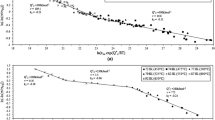Abstract
The theory of the Southwell plot is outlined and its history traced. Examples are given in which the technique fails to give a straight line; these are classified into low-load and higher-load nonlinearities. It is shown that the former may be due to inherent zero errors in the deflection measurement and that this can cause serious errors in the apparent critical loadP c. A new approach involving “pivot points” is introduced and used to formulate plots which may help to linearize the data; an application to one of Karman's classical column tests is given.
For plates, use is made of a general post-critical equation of which Donnell's result for a simply supported square plate is a special case. A new graphical technique is proposed for findingP c for plates with small imperfections, and applied to example data from published test results. A more general numerical technique is also proposed and applied to results from a test during which the experimental boundary conditions were changing.
Similar content being viewed by others
References
Croll, J. G. A. andWalker, A. C., Elements of Structural Stability, Macmillan, London, 65–90 (1972).
Southwell, R. V., On The Analysis of Experimental Observations In Problems of Elastic Stability, Proc. Royal Soc. London, Ser. A, (135),601–616 (1932).
Ayrton, W. E. and Perry, J., On Struts, The Engineer, London, 464–465 (Dec. 10, 1886) and 513–515 (Dec. 24, 1886).
Fidler, T. C., Bridge Construction, Griffin, London, 161–162 (1887).
Young, T., A Course of Lectures On Natural Philosophy And The Mechanical Arts,2,Johnson,London,47–48 (1807).
Westergaard, H. M., Buckling of Elastic Structures, Trans. ASCE,55,566–676 (1922).
Horton, W. H., Cundari, F. L. andJohnson, R. W., The Analysis of Experimental Data Obtained From Stability Studies On Elastic Column And Plate Structures, Israel J. Tech.,5 (1–2),104–113 (1967).
Donnell, L. H., On The Application of Southwell's Method For The Analysis Of Buckling Tests, Timoshenko 60th Anniv. Vol., McGraw-Hill, NY (1938).
Lundquist, E. E., Generalized Analysis of Experimental Observations I In Problems of Elastic Stability, NACA TN658, Washington (July 1938).
Christopherson, D. G., Determination of Critical Loads of Struts, Engineering, London, 629 (Nov. 16, 1951).
Ariaratnam, S. T., The Southwell Method For Predicting Critical Loads of Structures, Quart. J. Mech. & Appl. Math.,14,137–153 (1961).
Roorda, J., Some Thoughts About The Southwell Plot, Proc. ASCE,93,EM6,37–48 (Dec. 1967).
Leicester, R. H., Southwell Plot For Beam Columns, Proc. ASCE, EM6, 945–965 (Dec. 1970).
Karman, T. V., Untersuchungen ueber Knickfestigkeit, Mitteilungen ueber Forschungsarbeiten, 81, VDI, Berlin (1909).
EMPA Bericht 190, Ueber die Knickfestigkeit von Schweizerischen Fichten-, Tannen-, Laerchen-, Rotbuchen-und Eichenholz, Zürich (1960).
Wilson, J. F., Holloway, D. M. andBiggers, S. B., Stability Experiments On The Strongest Columns And Circular Arches,Experimental Mechanics,11 (7),303–308 (July 1971).
Schlack, A. L. Jr., Experimental Critical Loads For Perforated Square Plates, Proc. SESA,25 (1),69–74 (Feb. 1968).
Hoff, N. J., Boley, B. A. andCoan, J. M., Proc. SESA,5 (2),14–24 (1948).
Coan, J. M., Large Deflection Theory For Plates With Small Initial Curvature Loaded In Edge Compression, J. Appl. Mech.,18,143–151 (June 1951).
Bronshtein, I. N. and Semendyayev, K. A., Guide Book To Mathematics, Deutsch, Zürich, Part 6: Interpretation Of Experimental Results, 763–770 (1973).
Spencer, H. H., The Pivot Point Concept As A Tool For The Analysis Of Experimental Data, Research Seminar, Hatfield Polytechnic, England (June 1974).
Walker, A. C., The Numerical Analysis Of Compressed Plates (Lecture Notes),University College London, England (Sept. 1972).
Supple, W. J., Structural Instability, IPC, London, 70–78 (1973).
Yamaki, N., Postbuckling Behaviour Of Rectangular Plates With Small Initial Curvature Loaded In Edge Compression, J. Appl. Mech.,26,Trans. ASME, 81E,407–414 (1959).
Williams, D. G., Dorman-Long Ltd., Private Communication of “PLAP—Plate Analysis Program,” Melbourne, Australia (1971).
Author information
Authors and Affiliations
Rights and permissions
About this article
Cite this article
Spencer, H.H., Walker, A.C. Critique of Southwell plots with proposals for alternative methods. Experimental Mechanics 15, 303–310 (1975). https://doi.org/10.1007/BF02318661
Issue Date:
DOI: https://doi.org/10.1007/BF02318661




